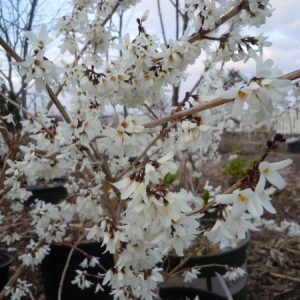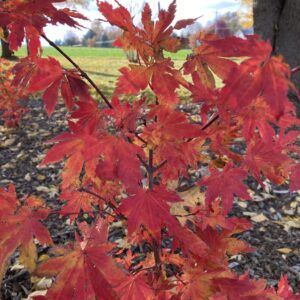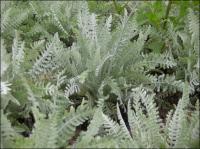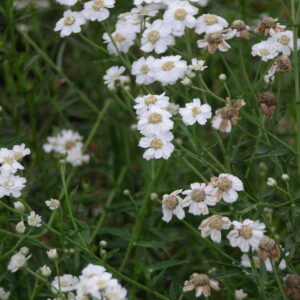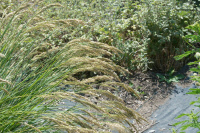Our Plants
Showing 1–8 of 587 results
-
Abeliophyllum distichum White forsythia, Korean Abelea-leaf Z. 5-8
Swan white, open cone-like blooms, each petal splitting then terminating with a notch, cascade along stems in very early spring, almond fragrance.
Swan white, open cone-like blooms, each petal splitting then terminating with a notch, cascade along stems in very early spring, almond fragrance.
Size: 3-5’ x 3-4’
Care: sun to part shade in moist to moist well-drained soil. Flowers bloom on old wood so prune right after flowering.
Native: central Korea, where it is now nearly extinct. This is the sole species in this genus.
Awards: Royal Horticultural Society Award of Merit in 1937 and RHS First Class Certificate in 1944.1st collected by Japanese botanist Takenoshin Nakai (1882-1952) before 1919. Nakai, professor, author, scholar and official botanist for Korea in 1910 after Japan annexed Korea following the Sino-Japanese and Russo-Japanese wars. There he explored the botanically unknown mountains and forests and introduced its plants to the world through his international contacts and his authorship of Flora Koreana. Abeliophyllum means leaves like an Abelia, a different shrub. In America’s Arnold Arboretum by 1924.
**LISTED AS OUT OF STOCK BECAUSE WE DO NOT SHIP THIS ITEM. IT IS AVAILABLE FOR PURCHASE AT OUR RETAIL LOCATION.
-
Acanthus spinosus Bear’s breeches Z 5-9
A WOW plant. Bodacious two-toned spikes of purple & white bracts, June to September. Glossy, deeply incised leaves. Both flowers and leaves terminate in thorny tips.
OUT OF STOCK
A WOW plant. Bodacious two-toned spikes of purple & white bracts, June to September. Glossy, deeply incised leaves. Both flowers and leaves terminate in thorny tips. One of internationally known garden designer Piet Oudolf’s 100 “MUST HAVE” plants, Gardens Illustrated 94 (2013)
LIMITED QUANTITIES AVAILABLE, LIMIT OF 1 PER CUSTOMER PLEASE.
Size: 3-4' x 2-3'
Care: Sun in well-drained soil. Be patient - slow to emerge in spring.
Native: Italy & Turkey
Wildlife Value: Attracts butterflies, Deer and rabbit resistant.The name Acanthus comes from the Greek akantha meaning “thorn” or “thistle” and spinosus means “spine” referring to the thorn on the leaf and flower tips Grown since at least 5thcentury B.C. Inspiration for Corinthian column capital in architecture of ancient Greece and Rome. According to one legend famous Athenian architect and sculptor, Callimachus, 5th century B.C. was charmed upon seeing this plant and adopted it for the top of columns he designed in Corinth. Philip Miller’s 1768 Gardener’s Dictionary, describes this as having “deeply jagged” leaves and “each segment is terminated with a sharp spine, as are also the foot-stalks of the leaves, and the empalement of the flower, which renders it troublesome to handle. . .”
-
Acer pseudosieboldianum Z 4-8 Korean maple
Small tree or large shrub. Medium to dark green leaves (to 5” long) with 9 doubly serrate lobes, Purple flowers bloom in corymbs in spring. Excellent shades of amber, carrot and garnet in fall. Appears like Japanese maples or Fullmoon maple but hardier.
Small tree or large shrub. Medium to dark green leaves (to 5” long) with 9 doubly serrate lobes, Purple flowers bloom in corymbs in spring. Excellent shades of amber, carrot and garnet in fall. Appears like Japanese maples or Fullmoon maple but hardier.
Size: 15-25’ x 15-25’
Care: sun to part shade in moist well-drained soil. Site out of wind.
Native: Eastern AsiaPseudo means false referring to the similarity of this to Acer sieboldianum. Korean maple is sometimes commonly called purplebloom maple in reference to its flower color.
First described in 1886 in German journal Botanische Jahrbücher für Systematik, Pflanzengeschichte und Pflanzengeographie 7(2): 199–200.**LISTED AS OUT OF STOCK BECAUSE WE DO NOT SHIP THIS ITEM. IT IS AVAILABLE FOR PURCHASE AT OUR RETAIL LOCATION.
-
Achillea clypeolata Yarrow Z 3-9
Mustard yellow platters in summer on fern-like, thick clumps of gorgeous, silver dissected foliage.
Mustard yellow platters in summer on fern-like, thick clumps of gorgeous, silver dissected foliage.
Size: 18" x 24"
Care: sun in well-drained to moist well-drained soil.
Native: BalkansAchillea named for Achilles, hero of Homer’s Illiad, who used Achillea millefolium to stop bleeding of his wounded soldiers. Clypeolata means “with a shield.” Described in 1813 in Fl. Graec. Prodr. 2: 193 (1813) giving credit to French botanist Joseph Tournefort (1656-1708.)
-
Achillea filipendulina Fernleaf Yarrow Z 3-10
June-July mustard yellow platters on erect stems. Good dried flowers.
June-July mustard yellow platters on erect stems. Good dried flowers.
Size: 3’-4’ x 30”
Care: Full sun in well-drained to moist-well-drained soil. Heat and drought tolerant
Native: Caucasus, Iran, Afganistan.Achillea named for Achilles, hero of Homer’s Iliad, used Achillea millefolium to stop bleeding of his wounded soldiers at the siege of Troy. Achilles learned about the uses of Achillea from Chiron, the Centaur. Introduced to gardens in 1804 when it was sent from the Caucasus to Europe.
-
Achillea ptarmica ‘The Pearl’ Sneezewort, Shirtbuttons Z 3-9
Spring - summer frilly, white “shirtbuttons”
Spring – summer frilly, white “shirtbuttons”
LIMITED QUANTITES AVAILABLE, LIMIT OF 1 PER CUSTOMER PLEASE.
Size: 12-36”x 24”
Care: Full sun, well-drained to moist well-drained soil.
Native: North temperate regionsPtarmica is Greek for sneeze because this plant used for snuff. English brides carried this at their weddings and called the plant “Seven years’ love.” Cultivated in Europe since the Middle Ages and in the U.S. since the 1700’s. The double form grown in English gardens by 1597. Philip Miller (1768) referred to this as “double Maudlin.” “The Pearl” described in the May 1905 edition of The Garden as “probably giving more satisfaction than any other white-flowered hardy perennial. The Pearl is a pearl indeed.”
-
Achlys triphylla Vanilla leaf, Sweet after death Z 5-9
A foot tall stem holds one large leaf divided into three, fan-shaped leaflets with deeply scalloped edges laying flat like a dinner plate. From spring to mid-summer an erect, white spike, not made of flowers, but made of stamens (the male part of plants that holds pollen) blooms.
OUT OF STOCK
A foot tall stem holds one large leaf divided into three, fan-shaped leaflets with deeply scalloped edges laying flat like a dinner plate. From spring to mid-summer an erect, white spike, not made of flowers, but made of stamens (the male part of plants that holds pollen) blooms.
Size: 8-16" x spreading by roots.
Care: shade to part shade in moist to moist well-drained soil
Native: mountains of the western US and Canadian coast up to nearly 5000’Natives of the Pacific Northwest used this medicinally to treat tuberculosis, cataracts, and induce vomiting, They also washed their hair with it and as an insecticide to repel or kill mosquitos, bedbugs and lice on sheep,
Both common names describe the sweet smell of its dried foliage. Collected by “Archibald Menzies on the west coast of North America.” Menzies (1754-1842) sailed on the Vancouver Expedition collecting many plants in 1787-1788. Cyclopedia or Universal Dictionary of Arts. Sciences, and Literature v. 20, p. (1812) where Sir James Edward Smith described and named it Loentic tripylla means Lion’s-leaf. Tripylla means three fruits. Renamed later. -
Achnatherum calamagrostis Silver spike grass Z 5-8
Elegant, tawny-silvery spikes sway in the breeze on this clumping grass from June all summer and fall.
Elegant, tawny-silvery spikes sway in the breeze on this clumping grass from June all summer and fall.
Size: 36" x 36"
Care: sun in moist well-drained soil
Native: Central & southern EuropeCollected before 1750. Calamagrostis is from Greek calamos for “reed” and agrostis for “grass.”

